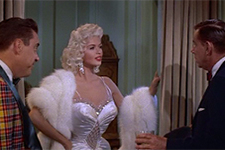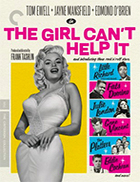The Girl Can't Help It
|  By any stretch, Frank Tashlin’s The Girl Can’t Help It is a uniquely bizarre film, one that is both a distinct product of its era, but also a strange experiment in melding genres and audience tastes that, at the time, were usually kept separate. At its narrative level, The Girl Can’t Help It is a traditional showbiz comedy-satire in which Tom Miller (Tom Ewell), a theatrical talent agent who has squandered his former success with too much booze, is hired by Marty “Fats” Murdock (Edmond O’Brien), a garrulous just-past-his-prime gangster, to turn his new girlfriend, the voluptuous Jerri Jordan (Jayne Mansfield), into a pop star even though she apparently has no ability to sing. What she does have, though, is Mansfield’s 40-21-35 dimensions, which for a comedy of this sort, is enough justification. At the same time, though, The Girl Can’t Help is a jukebox musical, sold heavily on the strength of its lineup of musical performers who appear throughout the film as themselves playing in various clubs (the promotional material prominently features the names and likenesses of the musicians, although they still play second-fiddle to Mansfield). Released in 1956, it followed several films, including The Blackboard Jungle (1955) and Teenage Crime Wave (1955), that were explicitly aimed at adolescent audiences and used the new musical form of rock’n’roll in their marketing. Early the next year, enterprising independent producer Sam Katzman churned out Rock Around the Clock (1956), a rock version of the Big Band musicals of the 1940s that heralded a new era in the merging of movies and popular music. That film’s success ensured that a whole slate of similarly themed and titled films would be rushed into production over the next year, mostly from independent producers who were ready and willing to exploit the disreputable new musical form: Shake, Rattle, and Rock! (1956), Rock, Rock, Rock! (1956), and Rock, Pretty Baby (1957), to name a few. The Girl Can’t Help It stood out from this flourishing new genre, and not just because it failed to include the word “rock” somewhere in the title. Its primary distinction was the fact that, despite prominently featuring musical acts like Little Richard, Fats Domino, The Platters, and Eddie Cochran, all of whom appealed primarily to the teenage market, the film features no teenagers. None. All of the other rock musicals focused on adolescent protagonists with whom their adolescent audiences could identity, but The Girl Can’t Help It exists in some fantastical netherworld populated entirely by adults who spend time in posh nightclubs headlined by musical acts that would never play such venues. In its own weird way, The Girl Can’t Help It attempted to package adolescent taste into a mainstream studio-produced film, underscored by the inclusion of musical acts like Ray Anthony, Abby Lincoln, and Julie London who would appeal primarily to parents. As the reviewer in Variety wrote, “While there are a number of Rock ‘n’ Roll features plying the market, The Girl Can’t Help is the first deluxe version.” The film was shot, after all, by cinematographer Leon Shamroy, who had already earned 12 Oscar nominations and won three (he would go on to win one more, although his work here was overlooked by the Academy). And, outside of the strange, major studio age-demographic intersection, The Girl Can’t Help It is just an odd film—delightfully so—part of which can be explained by the fact that co-writer/director Frank Tashlin originally worked as an animator whose most famous films were the zany Merrie Melody and Looney Tunes shorts he directed for the Leon Schlesinger unit at Warner Bros. He also worked briefly for Ub Iwerks, Hal Roach, and Walt Disney, and he wrote comic bits for The Marx Brothers, Lucille Ball, and Red Skelton. It should come as no surprise that six of his last seven films were Jerry Lewis comedies—Rock-A-Bye Baby (1958), The Geisha Boy (1959), Cinderfella (1960), It’s Only Money (1962), Who’s Minding the Store? (1963), and The Disorderly Orderly (1964)‚ which partially accounts for his being better known among French cinephiles than Americans (the French film journal Positif dedicated a whole issues to him in 1958, which he was surprised to see on a shelf in a bookstore in Paris and was unable to read because he didn’t know French). Unfortunately, Tashlin’s name has been largely obscured in the history books by the comic actors with whom he collaborated, although Peter Bogdanovich did include an interview with him in his book Who the Devil Made It alongside the likes of Howard Hawks, Alfred Hitchcock, Fritz Lang, and Josef von Sternberg. The Girl Can’t Help It was originally based on the short story “Do Re Mi” by screenwriter Garson Kanin (Adam’s Rib), which was originally published in The Atlantic magazine in March 1955. But, by the time Tashlin and Herbert Baker, a screen- and songwriter with whom he had previously worked on the Martin-and-Lewis comedy Artists and Models (1955), were through with it, it was so different that Kanin asked for his name to be removed. As an animator and gag writer, Tashlin loved big jokes and borderline-surreal absurdity, which allowed him to often have his cake and eat it, too. In numerous interviews Tashlin noted the humor he found in American male sexuality and the attendant fetishization of female bodies, especially breasts, and when viewed from that perspective, The Girl Can’t Help It is a veritable take-down of female objectification. Take, for example, the famous scene in which Mansfield, a former Playboy Playmate in her first starring role, walks down the street, catching the eye of every man she passes without ever seeming to notice. The exploitation of Mansfield as an object of the male gaze is played straight—everyone in the audience gets to visually oogle Mansfield in the same way as all the characters on screen—and it is satirized, as Tashlin throws in various cartoonish effects such as the ice-delivery man’s block of ice melting, the milk-delivery man’s bottle of milk boiling over, and one guy’s glasses shattering right on his face, the lenses apparently not strong enough to withstand Mansfield’s sexuality. A similar point could be made with the scene in which Fats first introduces Tom to Jerri, who we see before Tom does standing in a doorway, staring vacantly into space while waiting to be seen. She is thus not just an object, but an object who knows she is an object and purposefully behaves as such, positioning herself for maximum visibility. No surprise, then, that Tom’s primary means of “promoting” her is to take her to various clubs and have her walk to the ladies’ room, thus guaranteeing male visual attention. The loosening of the industry’s formerly taut Production Code can be charted across virtually every scene in the film, belying all the trouble Howard Hughes had with The Outlaw (1946), a Western that was sold more on Jane Russell’s sex appeal than action, a mere decade earlier. Double entendres fly from all corners, and Tashlin is never above framing Mansfield so that her endowments dominate the frame (to the point that her cleavage could easily be given a separate credit). Tashlin was no stranger to pushing the limits of suggestive humor, as a number of his ideas for Arists and Models were nixed by the Production Code Administration, including naming Jerry Lewis’s character Fullstick. However, because The Girl Can’t Help It is so purposefully cartoonish in both its visual construction and its tonalities, one can imagine the otherwise strict moralists at the PCA giving it a pass because Mansfield’s Jerri is about as real as the animated sexpots in Tex Avery cartoons (which, of course, doesn’t make her any less problematic in terms of female representation, but does speak to our inherit tendency to treat different kinds of images differently in terms of their perceived effect). Jayne Mansfield is not the film’s only special effect, though. As actor Tom Ewell informs us in the film’s opening prologue, The Girl Can’t Help It “was photographed in the grandeur of CinemaScope,” Fox’s recently patented anamorphic widescreen process, the horizontal dimensions of which he accentuates by snapping his fingers and causing the edges of the frame to open up and reveal more visual space on either side. But, more than that, it was also shot in “gorgeous, lifelike color by DeLuxe,” which we see highlighted as the previously black-and-white image suddenly morphs into the gaudy Technicolor-esque hues of red, blue, and teal, which are anything but “lifelike.” But, they fit The Girl Can’t Help It perfectly, as does the moment when Ewell’s stagy monologue about “the music that expresses the culture, the refinement, and the polite grace of the present day” is suddenly drowned out by a jukebox blaring the raucous sound of Little Richard’s title song, which John Waters would later appropriate for Divine’s Mansfield-esque stroll through the squalor of pre-gentrification Baltimore in his notorious Pink Flamingos (1972). That single image of Tom Ewell on one side, wearing a white-tie tuxedo and speaking without being heard, and the gaudily lit jukebox on the other side blaring rock’n’roll, is singular in its summation of what the film has to offer and how delightfully weird it is in trying to straddle multiple generations, genres, and tones. A real cartoon couldn’t have done better.
Copyright © 2022 James Kendrick Thoughts? E-mail James Kendrick All images copyright © The Criterion Collection | |||||||||||||||||||||||||||||
Overall Rating: 

 (3)
(3)


